Acoustics for the background sound of the premises
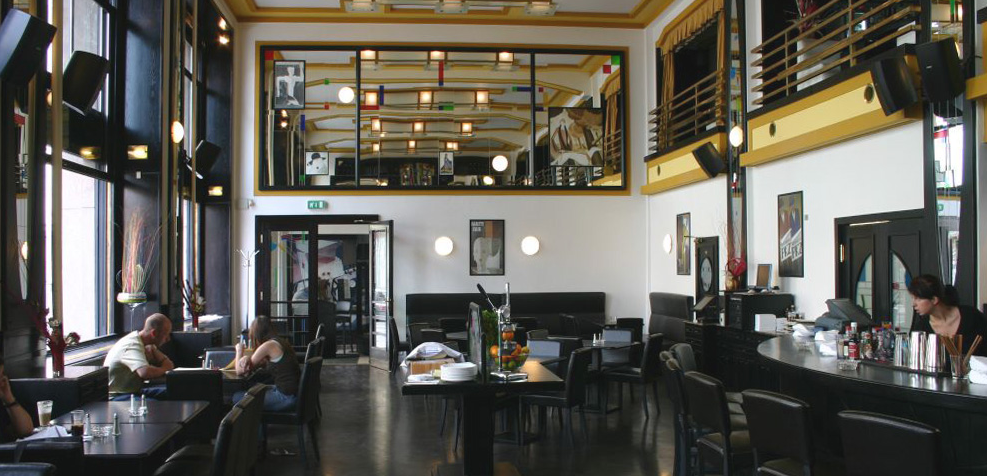
In the fifteenth issue of the “Sound” show, we talk about acoustics for rooms, various myths related to this topic [ Read more about the podcast ] [ Listen to this release ].
Other podcast releases
- [ read ] [ listen ] Who may be interested in the development of acoustics;
- [ read ] [ listen ] Music lovers, network players and built-in speakers;
- [ read ] [ listen ] Every engineer wants to make an S-90;
- [ read ] [ listen ] Simple words about headphones and DACs;
- [ read ] [ listen ] Talking about vinyl: Myths, opinions and current situation;
- [ read ] [ listen ] Answers to questions from the listeners of the Sound podcast;
- [ read ] [ listen ] Discuss the nature of the different sound of acoustics;
- [ read ] [ listen ] Acoustics for the background sound of the premises;
- [ read ] [ listen ] Answers to questions from podcast listeners;
- [ read ] [ listen ] We are talking about home theaters;
- [ read ] [ listen ] Interiors for sound;
- [ read ] [ listen ] Interfaces and cables;
- [ read ] [ listen ] Simple words about digital and analog sound;
- [ read ] [ listen ] Home speakers and questions;
- [ read ] [ listen ] Engineer's opinion: How to create your own ecosystem of sound;
- [ read ] [ listen ] Audio quality: Should I trust "beautiful graphics" and reviews in the press;
- [ read ] [ listen ] Answers to questions from listeners;
Dmitry Kabanov: We have already discussed various aspects of room sounding before, and did it in the winter when we discussed moisture-proof speakers that are resistant to snowfall. It's almost autumn now, it has started to rain, and it’s worth going back to this topic.
')
Timofey Shikolenkov: Good theme. But first let's talk about the related topic, which is with us every day - let's talk about the equipment, the sound in public places . Coming to a bar, you sometimes see a tape recorder on the rack, almost a cassette center, playing radio. There are cases: you come to a newly opened establishment, where you made beautiful repairs and at the same time bought some incomprehensible equipment and put it on a rack. This oddity always amazed me.
The second thing that surprises, however, is less common: in some rooms where ceiling speakers are usually used - in large spaces they practically do not take up space and make a uniform dubbing - instead of special built-in speaker systems they put car speakers.
Dmitry: They realized that they didn’t need to put a tape recorder on the shelf, bought some center 5.1, 2.1 and decided to distribute it all to the corners on the ceiling.
Timofey: I even saw situations when [in public places] put a car stereo with a transformer and lead the wires to the car speakers located on the ceiling. People do not understand that car speakers are designed for the volume that accommodates the body of the car.
It is important to understand that for each speaker a very important factor is the acoustic design, that is, in which box, case it is located.
Dmitry: I represent a cafe the size of an average sedan. It would be nice to sit.
Timofey: Unlikely. People try to reinvent the wheel. Probably, they are guided by the fact that professional equipment, and the word “professional” always scares everyone, expensive. Professional speakers that are designed for voice, background music, are cheap.
There are such variants of acoustic systems: a small column, ceiling or wall, costs about a thousand rubles. She needs an amplifier. In such cases, hybrid devices and mixer amplifiers are commonly used. This is one box that can be put in a rack or another convenient place.

Professional active speakers Eurosound ES-5A
Professional equipment designed to work 24/7 - around the clock for a long time. Household audio equipment is not designed for such use, it is not able and should not work that way. It has a definite, end-of-life and operating condition.
In this case, the amplifier is needed in any case. Maybe automobile equipment seems to people most familiar, and [therefore] they put it.
The situation is similar when an [home] printer intended for a small print volume is bought in the office and is printed from morning to evening. During the warranty period, the printer breaks down, and workers do not understand what happened. It's good that during the warranty period, and not a day later. The device is not intended to operate in this mode.
Returning to the topic of audio: the economic aspect is incomprehensible, it is not justified. The same car radio costs money, it must also be adapted to work outside the car.
Dmitry: It will be more expensive, and it must be strengthened, but this is not provided for by the construction.
Timofey: The money will be the same. Questions of reliability, stability, volume are also important. I have long wanted to talk about the volume. Everyone loves to measure loudness in watts, although this is a measure of power. And people think that the larger the number written on the speaker or amplifier, the louder.
Of course, these values are to some extent combined with each other, but the volume is not measured in watts. Loudness is measured in decibels - this is sound pressure. This is the primary value in which the volume is measured.
In the professional equipment in the description of the characteristics of the acoustic systems sound pressure is always indicated. It is very important. To understand what numbers can be indicated there: ten decibels is a quiet whisper, rustling leaves, fifty decibels is the sound pressure that we create during a quiet conversation.
In headphones or speakers, sound pressure is different. Seventy-seventy-five decibels is a scream, ninety decibels is a subway car passing us. One hundred twenty decibels is a pain threshold, more people can not bear.
If we want to voice the room in which people sit and work, it should be quiet music. If this is a warning system ... there is such a phrase “public address” in English, you can try to translate it into Russian as “broadcast”, “broadcast”, “warning system”. Just in the Russian language there is no such phrase.
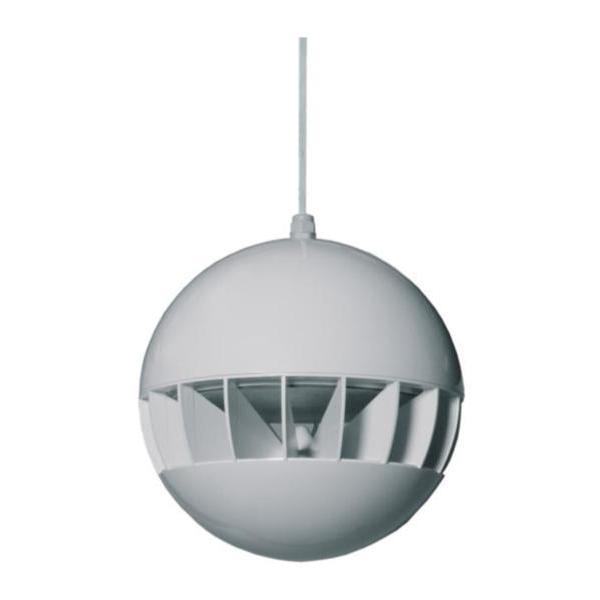
Wall loudspeaker APart SPH20
Dmitry: It looks like a system like it used to be at [western] universities, when an ad is turned on or a local radio station is broadcast. Something like that.
Timofey: This is the same as the apartment's radio points, that is, the sockets, which include a loudspeaker. Returning to the power: more than 85 decibels in the room where people are sitting, who need to be notified, should not be, but the music should be even quieter. In professional acoustics, sound pressure is usually indicated at a distance of 1 meter at a power of 1 watt.
We turn to power. If we take small ceiling or wall speakers in which the maximum sound pressure is 92 decibels, that is, more than we need, then it turns out that at 1 watt we will get what we need.
Dmitry: It turns out that you do not need to buy amplifiers for 100 watts and spend a lot of money on it.
Timofey: A second question arises: why is such equipment recommended to be used? Very easy to calculate power. If power is indicated on the amplifier, for example, 100 watts, this means that we can connect one hundred speakers with a power of 1 watt to it. In professional equipment, marketing “tricks” are rarely used. “They attributed an extra zero, and immediately everyone ran to buy, so loud, so powerful,” there is no such thing.
If it is written on the systems of public address that the column power is 2 or 3 W, 5 or 20 W, then this is the way it is. The column is designed for the power that will be fed from the amplifier. The volume depends on the room and the distance - we have already spoken.
Another advantage of such systems: these systems allow the use of sufficiently long cables, you can transmit sound over long distances - several hundred meters. It turns out something average: on the one hand, professional application, on the other hand - not entirely domestic.
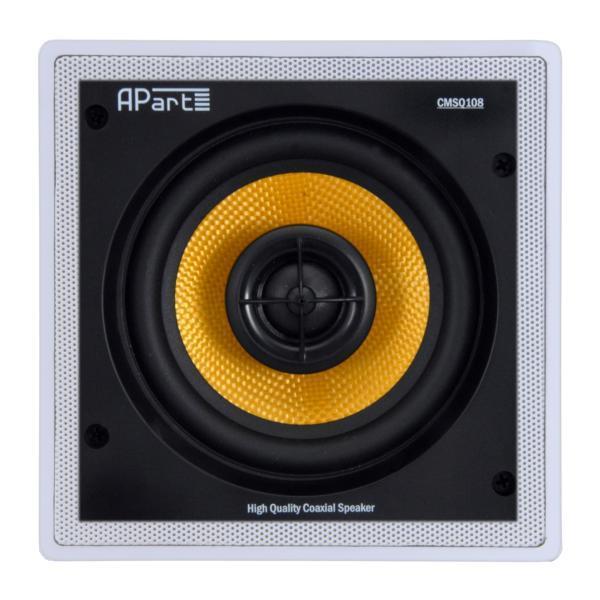
Built-in acoustics Apart CMSQ108
Dmitry: Given that the cable is laid on the walls, and the room can be large, the voice of fifty square meters will require tens of meters of cable.
Timofey: Of course, and it is very convenient. Why? Traditional Hi-Fi systems require each column to pull its own cable, this is a given. In the case of public address systems, this is not required. You can connect in parallel a large number of speakers, as long as necessary.
It is interesting that on such speakers there is a power switch, that is, conventionally, a volume control for each speaker. In the bar, restaurant, where the cashier is located, it is necessary that the sound is quieter, and the speakers may be the same.
Dmitry: You can physically limit [the power supplied] to these speakers ...
Timofey: Yes, it is for these speakers without any adjustments in the amplifier. And on the amplifier there is a general volume control and, accordingly, in some zones we can make it quieter, in some - louder. This will change the power that will need to be calculated based on the capabilities of the amplifier.
It would be nice to make a small margin of power so that the amplifier does not work at the limit. If we buy a 35-watt, 50-watt amplifier, then these are real and sufficient numbers, we have already discussed.
Dmitry: Let's talk about prices.
Timofey: A mixer-amplifier is a hybrid device that immediately with a volume control and an amplifier with a power of about 35-50 watts costs about ten thousand rubles. There are more “fancy” devices and completely hybrid devices sold with the source. As a rule, the source is either a computer that is nearby, or any player. The main task is to find an object where to turn on the sound source.
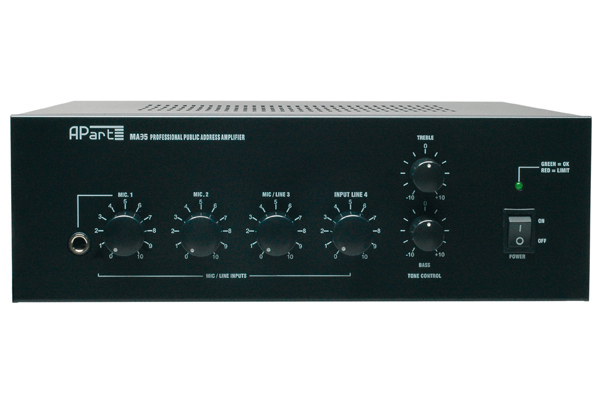
Mixer Amplifier APart MA35
Dmitry: We can physically limit the power on certain speakers, and if we have some old systems from what we have already used, for example, an old stereo system, can we partially use these speakers, in addition to what we buy?
Timofey: No way. Because the main difference between these systems is that they increase the amplitude about five times during transmission. That is, there is a step-up transformer in the amplifier, and no Hi-Fi or non-Hi-Fi, that is, ordinary household speakers, are designed for this.
In the columns there is a step-down transformer, and the speaker does not work in extreme mode. If you connect conventional speakers that are not designed for this, for a while they will work at the limit and fail quite quickly. No need to use such options. One column for such a professional system can cost about a thousand rubles. A good one costs two thousand rubles, a very good one - three or four thousand.
They can be of different capacities, but if this is a background subsound, then, as a rule, these are ceiling or wall systems. It all depends on how they are located in the room. The street system variant is possible, and all this is connected to one amplifier.
Dmitry: If we take a small cafe - is it 50-70 thousand rubles for all the equipment?
Timofey: No Twenty, a maximum of thirty thousand rubles, and then, if we want to build something super-quality. If you just make a background sound, you can limit yourself to twenty thousand, including waterproof speakers on the veranda. It is strange that people try to solve the problem in complex ways, despite the fact that there is a solution that is very inexpensive, and most importantly, easy to install.
An inexpensive cable is taken, laid along the wall, a gap is made in the right place, a speaker is connected, which is put in this place. You can add speakers anywhere if there is a cable reserve. No need to pull a hundred cables to a hundred speakers. All this is very simple, convenient and durable.
Dmitry: Does it make sense to think about wireless solutions?
Timofey: No Wireless solutions exist, but they are domestic. This means that they are not designed for long-term work.
Dmitry: We dealt with the case of a small cafe. If we have an average and closer to a large cafe, then we can observe there a division into two, three segments, where, among other things, some mini-scene can be used for micro-performances.
Timofey: Yes, that often happens, since all these systems and mixer amplifiers are usually multichannel. There are, of course, single-channel channels and there are quite a few of them, designed for several zones.
In this case, you can adjust the volume and connect a microphone. Naturally, they all come with microphone inputs: with one, two, three, four, different sources. You can send different sources to different zones. All this, again, is done once and is further controlled in one place by one simple device.
Dmitry: If necessary, you can bring the sound that comes from the microphone from the performer to the farthest corner and the zone, or, on the contrary, remove the sound and send music to it that does not prevent people from enjoying what they are doing.
Timofey: The main thing is that these planned zones from the very beginning should be connected to the amplifier at different outputs, that is, the outputs of different zones. If we initially made only one zone, then it is not necessary to hope that the speakers themselves will understand what sound they play.
When we talk about performance, about live sound, such systems are no good. As a rule, if we are talking about restaurants and bars, then other equipment is used for stage equipment - mixers, scenic large professional speakers. In institutions where there is a daytime sounding at the same time, and in the evening - a stage, perhaps a disco, live performance, two systems are used.
Firstly, it is the public address, that is, the sound of the day, and in the evening - powerful professional acoustics, you can connect musical instruments to the bark. Such a hybrid.
Dmitry: If you compare with a small cafe, how much will this solution cost more?
Timofey: It depends on how many speakers are there, how different sources are needed, for example, simple amplifiers can be divided into zones. Take a microphone: there is background music that plays everywhere, and there is an automatic music muting function at the start of some kind of alert, as soon as you start speaking into the microphone. As a rule, that's all.
If you need to do something more, you can put two mixer amplifier and make two separate systems. There are multizone, more serious mixer amplifiers or separate amplifiers and mixers. The space for creativity is unlimited. It all depends on the task. The main message I wanted to make for our listeners is that it is very simple.
My friend, opening a cafe, turned to me for help in the field of sound. During the evening we did everything. It took more time to drill holes in the walls to fix the wall speakers. The cable was laid very quickly, where you need to connect the speakers.
Dmitry: The main conclusion: “professional” does not mean that it is expensive, it means that it is necessary for work, and not so difficult — not to build a rocket.
Timofey: As for the professional, in this area “professionally” means “inexpensively”. And you need to understand that the equipment is very different, and if the column is similar to a column, then this does not mean that it is suitable for any task. Tasks are different, and there are many.
And if we know what equipment is suitable for what tasks, then we easily solve them, without spending a lot of money, investing in the future, because it will work for a long time, without requiring maintenance. This is reliability, quality, and a reasonable waste of money, which is what everyone is looking for.
Dmitry: There are more questions that are often asked by those who want to do this?
Timofey: You can talk about street things to talk.
Dmitry: What to do in the fall and winter?
Timofey: It happens that people buy waterproof speakers, and they are very different. There is a standard that describes how much moisture can get on the speaker system.
There was a case when a client came with the wish to install columns in the pool into the water. It was not possible to find out from him why this is, because nothing will be heard. Unfortunately, we could not help him.
In general, there are different classes and you need to understand that if it hangs outside under the roof, and it will be a humid environment, water will not flow directly, this is one system, if the completely open space is another system, if the sauna is 100% humidity third system.
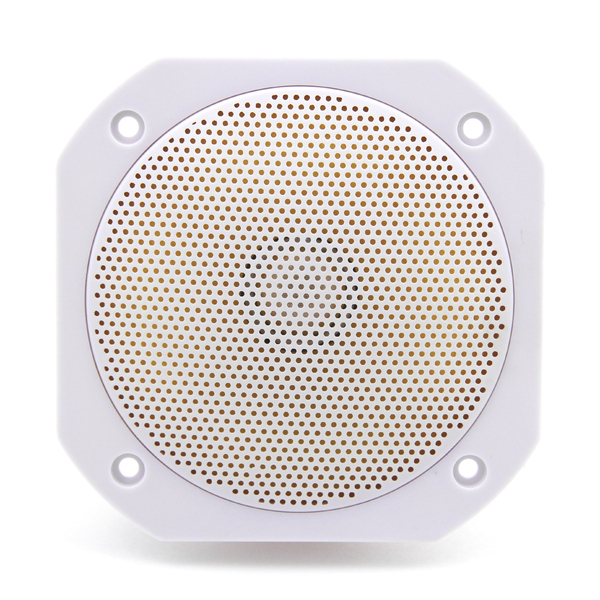
Waterproof speaker Visaton FRS 10 WP / 8
Dmitry: There is a class of protection against moisture, which you need to pay attention.
Timofey: We need to look in the description for which application this acoustics are used.
Dmitry: If you recall the systems that look like floor stones and stuff. How much does it cost to use on the street?
Timofey: There are such very interesting and beautiful landscape solutions. It is necessary to carefully read, for which application they are, external or internal. If the column looks like a beautiful pebble, it does not mean that it can be put on the track. We need to see what class protection from moisture.
If it is assumed that the column will be placed in the lowland, then the equipment must be of the appropriate class, or else it is necessary to reorient and move the column to another place. In principle, nothing will change, plus or minus half a meter is not very important, and the system will be more durable.
Dmitry: Are there moments of shock resistance? Random contacts with furniture? Can people hurt something?
Timofey: No, as a rule, everything is built into the ceiling or hung on walls or corners. Impact resistance is difficult to apply. The speakers are made of plastic with various elements, you can't beat them with fists, of course.
Source: https://habr.com/ru/post/366745/
All Articles